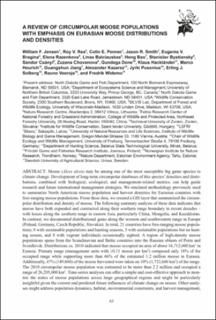| dc.description.abstract | Alces alces, Asia, distribution, Eurasian elk, Europe, GIS, harvest, moose, population density | en_US |
| dc.description.abstract | Moose (Alces alces) may be among one of the most susceptible big game species to climate change. Development of long-term circumpolar databases of this species’ densities and distributions, combined with biological, ecological, and management-related metrics, can help guide research and future international management strategies. We emulated methodology previously used to summarize North American moose population and harvest densities for Eurasian countries with free-ranging moose populations. From these data, we created a GIS layer that summarized the circumpolar distribution and density of moose. The following summary analysis of these data indicates that moose have both expanded and contracted along their southern range boundary in recent decades – with losses along the southern range in eastern Asia, particularly China, Mongolia, and Kazakhstan. In contrast, we documented distributional gains along the western and southwestern range in Europe (Poland, Germany, Czech Republic, Slovakia). In total, 21 countries have free-ranging moose populations; 8 with sustainable populations and hunting seasons, 5 with sustainable populations but no hunting season, and 8 with vagrant individuals occasionally sighted. A region of high-density moose populations spans from the Scandinavian and Baltic countries into the Russian oblasts of Perm and Sverdlovsk. Distributions ca. 2010 indicated that moose occupied an area of about 16,712,600 km2 in Eurasia. Primary range (management units with ≥0.11 moose per km2) composed only 18% of the occupied range while supporting more than 66% of the estimated 1.2 million moose in Eurasia. Additionally, 47% (149,860) of the moose harvested were taken on 10% (1,722,660 km2) of the range. The 2010 circumpolar moose population was estimated to be more than 2.2 million and occupied a range of 26,205,000 km2. Time-series analyses can offer a simple and cost-effective approach to monitor the status of moose populations across large geographical regions and might be particularly insightful given the current and predicted future influences of climate change on moose. Other analyses might address population dynamics, habitat, environmental constraints, and harvest management, among other issues. We encourage jurisdictions to cooperate strategically in implementing and coordinating
GIS analyses to monitor, assess, and manage moose populations around the world. We believe
these maps can serve as a useful tool for educating the public and policy makers about the importance
of habitat and land use practices with respect to maintaining sustainable populations of moose and
other species that are dependent upon boreal, temperate broadleaf, and mixed forests. | en_US |
